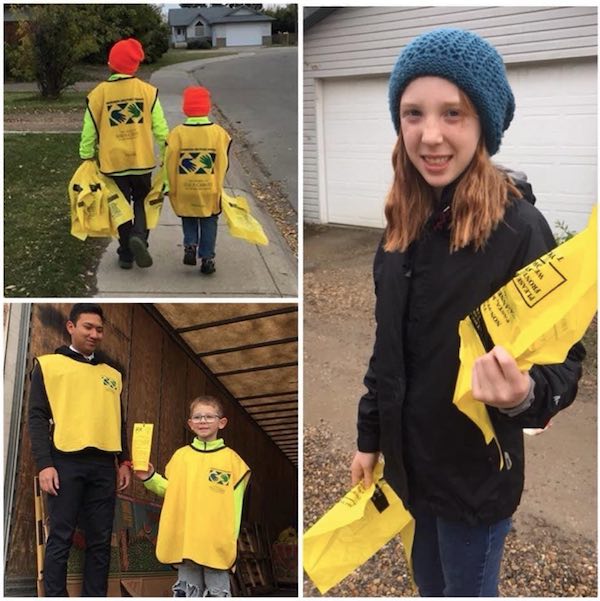Community
Fill those yellow bags to ease shortages at the Red Deer Food Bank

Article submitted by The Church of Jesus Christ of Latter-day Saints
The Red Deer Food Bank is consistently running out of specific food items. On October 23, Red Deer residents in the north half of the city are invited to participate in a food drive to help feed hungry central Alberta families.
It’s not surprising that the Red Deer Food Bank is experiencing increased demand in the middle of a pandemic. While the food bank is doing a good job of meeting the needs of most users, there have been shortages in some food items. “We consistently run out of specific items like Kraft Dinner, canned beans and canned fruit,” explained Mitch Thomson, executive director of the Red Deer Food Bank. “We’ve been holding our own, but we’re consistently unable to provide those items. Forty percent of those served by the Red Deer Food Bank are children and comfort foods like macaroni and cheese is always in demand.” Other items that are always in demand include canned vegetables, tomato sauce, spaghetti sauce, and canned dinners like beefaroni and hearty soups. All food
donations are used and appreciated.
How COVID has Affected the Red Deer Food Bank
The citizens of Red Deer have been very supportive of the Red Deer Food Bank and that has allowed the food bank to meet the increased needs it has seen since the pandemic began. It’s important to note that the Red Deer Food Bank supports 23 other food banks. It’s the only food bank in central Alberta that is
open five days a week and users come from Red Deer as well as other locations in the region. COVID has also resulted in a decrease in the numbers of volunteers who can assist stocking shelves, assembling and handing out hampers, and sorting donated food.
What’s New at the Red Deer Food Bank
The Red Deer Food Bank is getting a more functional truck to transport food thanks to support from local donors. They’ve also moved bays, so that the warehouse area is now right next to the food bank.
A COVID-Friendly Food Drive
Food drives organized by members of the Church of Jesus Christ of Latter-day Saints in Red Deer have become an important way for the Red Deer Food Bank to stock its shelves. The upcoming food drive will involve additional precautions to prevent the spread of COVID-19. “Volunteers will drop off bags on the doorsteps of homes beginning on October 18 and then pick them up on October 23 without making any personal contact,” explained Allison Strate, Red Deer Stake Food Drive Coordinator. “The bags will then be transported to the church and be placed on a truck to go to the Red Deer Foodbank. All volunteers will be wearing the appropriate personal protective equipment. We are hoping it will all run smoothly. We believe we can safely run the spring food drive and with the help of local citizens collect much needed food for those in need.”
How to Participate in the Fall Food Drive
Bags will be delivered to the doorsteps of homes on the north side of the city the week of October 18 and they will be picked up on Saturday October 23 between 10 am and 12 noon and delivered to the Red Deer Food Bank.
All north-area residents are reminded to please support the food bank by leaving a food donation on their doorstep on Saturday, October 23. Anyone who does not get a yellow bag in their mailbox is welcome to bring donations to the Kentwood chapel of the Church of Jesus Christ of Latter-day Saints (8 Keast Way) between 10 am and noon on Saturday, October 23. Any community members or groups that would like to assist in delivering or picking up bags are welcome to contact Alison Strate, the Red Deer Stake Food Drive Coordinator at [email protected].
The Red Deer food drives are part of a series of food drives organized by members of the Church of Jesus Christ of Latter-day Saints. “The food drive is a huge undertaking with hundreds of volunteers working together for a really important cause,” says Allison Strate, Red Deer Stake Food Drive Coordinator. “It’s a wonderful opportunity to provide an important service to families and individuals who need help from the Red Deer Food Bank to put food on their tables.”
Community
SPARC Red Deer – Caring Adult Nominations open now!

Red Deer community let’s give a round of applause to the incredible adults shaping the future of our kids. Whether they’re a coach, neighbour, teacher, mentor, instructor, or someone special, we want to know about them!
Tell us the inspiring story of how your nominee is helping kids grow up great. We will honour the first 100 local nominees for their outstanding contributions to youth development. It’s time to highlight those who consistently go above and beyond!
To nominate, visit Events (sparcreddeer.ca)

Addictions
‘Harm Reduction’ is killing B.C.’s addicts. There’s got to be a better way

From the Frontier Centre for Public Policy
B.C. recently decriminalized the possession of small amounts of illicit drugs. The resulting explosion of addicts using drugs in public spaces, including parks and playgrounds, recently led the province’s NDP government to attempt to backtrack on this policy
Fuelled by the deadly manufactured opioid fentanyl, Canada’s national drug overdose rate stood at 19.3 people per 100,000 in 2022, a shockingly high number when compared to the European Union’s rate of just 1.8. But national statistics hide considerable geographic variation. British Columbia and Alberta together account for only a quarter of Canada’s population yet nearly half of all opioid deaths. B.C.’s 2022 death rate of 45.2/100,000 is more than double the national average, with Alberta close behind at 33.3/100,00.
In response to the drug crisis, Canada’s two western-most provinces have taken markedly divergent approaches, and in doing so have created a natural experiment with national implications.
B.C. has emphasized harm reduction, which seeks to eliminate the damaging effects of illicit drugs without actually removing them from the equation. The strategy focuses on creating access to clean drugs and includes such measures as “safe” injection sites, needle exchange programs, crack-pipe giveaways and even drug-dispensing vending machines. The approach goes so far as to distribute drugs like heroin and cocaine free of charge in the hope addicts will no longer be tempted by potentially tainted street drugs and may eventually seek help.
But safe-supply policies create many unexpected consequences. A National Post investigation found, for example, that government-supplied hydromorphone pills handed out to addicts in Vancouver are often re-sold on the street to other addicts. The sellers then use the money to purchase a street drug that provides a better high — namely, fentanyl.
Doubling down on safe supply, B.C. recently decriminalized the possession of small amounts of illicit drugs. The resulting explosion of addicts using drugs in public spaces, including parks and playgrounds, recently led the province’s NDP government to attempt to backtrack on this policy — though for now that effort has been stymied by the courts.
According to Vancouver city councillor Brian Montague, “The stats tell us that harm reduction isn’t working.” In an interview, he calls decriminalization “a disaster” and proposes a policy shift that recognizes the connection between mental illness and addiction. The province, he says, needs “massive numbers of beds in treatment facilities that deal with both addictions and long-term mental health problems (plus) access to free counselling and housing.”
In fact, Montague’s wish is coming true — one province east, in Alberta. Since the United Conservative Party was elected in 2019, Alberta has been transforming its drug addiction policy away from harm reduction and towards publicly-funded treatment and recovery efforts.
Instead of offering safe-injection sites and free drugs, Alberta is building a network of 10 therapeutic communities across the province where patients can stay for up to a year, receiving therapy and medical treatment and developing skills that will enable them to build a life outside the drug culture. All for free. The province’s first two new recovery centres opened last year in Lethbridge and Red Deer. There are currently over 29,000 addiction treatment spaces in the province.
This treatment-based strategy is in large part the work of Marshall Smith, current chief of staff to Alberta’s premier and a former addict himself, whose life story is a testament to the importance of treatment and recovery.
The sharply contrasting policies of B.C. and Alberta allow a comparison of what works and what doesn’t. A first, tentative report card on this natural experiment was produced last year in a study from Stanford University’s network on addiction policy (SNAP). Noting “a lack of policy innovation in B.C.,” where harm reduction has become the dominant policy approach, the report argues that in fact “Alberta is currently experiencing a reduction in key addiction-related harms.” But it concludes that “Canada overall, and B.C. in particular, is not yet showing the progress that the public and those impacted by drug addiction deserve.”
The report is admittedly an early analysis of these two contrasting approaches. Most of Alberta’s recovery homes are still under construction, and B.C.’s decriminalization policy is only a year old. And since the report was published, opioid death rates have inched higher in both provinces.
Still, the early returns do seem to favour Alberta’s approach. That should be regarded as good news. Society certainly has an obligation to try to help drug users. But that duty must involve more than offering addicts free drugs. Addicted people need treatment so they can kick their potentially deadly habit and go on to live healthy, meaningful lives. Dignity comes from a life of purpose and self-control, not a government-funded fix.
Susan Martinuk is a senior fellow at the Frontier Centre for Public Policy and author of the 2021 book Patients at Risk: Exposing Canada’s Health Care Crisis. A longer version of this article recently appeared at C2CJournal.ca.
-

 COVID-192 hours ago
COVID-192 hours agoCDC Quietly Admits to Covid Policy Failures
-

 COVID-195 hours ago
COVID-195 hours agoJapanese study shows disturbing increase in cancer related deaths during the Covid pandemic
-

 Freedom Convoy2 days ago
Freedom Convoy2 days agoTrudeau’s use of Emergencies Act has cost taxpayers $73 million thus far
-

 Alberta2 days ago
Alberta2 days agoDanielle Smith warns arsonists who start wildfires in Alberta that they will be held accountable
-

 Frontier Centre for Public Policy2 days ago
Frontier Centre for Public Policy2 days agoThe Smallwood solution
-

 Agriculture2 days ago
Agriculture2 days agoBill C-282, now in the Senate, risks holding back other economic sectors and further burdening consumers
-

 Bruce Dowbiggin1 day ago
Bruce Dowbiggin1 day agoWhy Are Canadian Mayors So Far Left And Out Of Touch?
-

 National2 days ago
National2 days agoCanada’s Governor General slammed for hosting partisan event promoting Trudeau’s ‘hate speech’ bill




